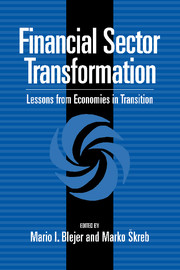Book contents
- Frontmatter
- Contents
- List of Contributors
- Introduction: Financial Reforms and Economic Transition: An Overview of the Major Issues
- PART I GENERAL STUDIES
- PART II COUNTRY STUDIES
- 5 Banking Crises in the Baltic States: Causes, Solutions, and Lessons
- 6 Monetary and Exchange Rate Policy, Capital Inflows, and the Structure of the Banking System in Croatia
- 7 Monetary and Financial Market Reform in Transition Economies: The Special Case of China
- 8 The Financial Sector and High Interest Rates: Lessons from Slovenia
- 9 Bank Rehabilitation in Slovenia: With Emphasis on Nova Ljubljanska Banka
- 10 Liberalization and Financial Reforms: Lessons from the Israeli Experience
- PART III AFTERWORD
- Index
6 - Monetary and Exchange Rate Policy, Capital Inflows, and the Structure of the Banking System in Croatia
Published online by Cambridge University Press: 05 November 2011
- Frontmatter
- Contents
- List of Contributors
- Introduction: Financial Reforms and Economic Transition: An Overview of the Major Issues
- PART I GENERAL STUDIES
- PART II COUNTRY STUDIES
- 5 Banking Crises in the Baltic States: Causes, Solutions, and Lessons
- 6 Monetary and Exchange Rate Policy, Capital Inflows, and the Structure of the Banking System in Croatia
- 7 Monetary and Financial Market Reform in Transition Economies: The Special Case of China
- 8 The Financial Sector and High Interest Rates: Lessons from Slovenia
- 9 Bank Rehabilitation in Slovenia: With Emphasis on Nova Ljubljanska Banka
- 10 Liberalization and Financial Reforms: Lessons from the Israeli Experience
- PART III AFTERWORD
- Index
Summary
Although heavily affected by war, Croatia has undertaken fundamental macroeconomic reforms since achieving independence in 1991. High inflation was brought under control in late 1993 by an exchange-rate-based stabilization program, and inflation has been kept to an average annual level of 1.2 percent in the three years since stabilization. This is the lowest level among transition countries (Figure 6.1). Reform of monetary instruments, currentaccount convertibility, and fiscal consolidation were part of the stabilization effort. However, imperfect financial markets faced strong capital inflows. The associated current-account deficit complicates maintenance of stabilization in the long run.
Competitive forces are at work to address the shortcomings of the financial system, but each source of competition has its own limitations. Entry into Croatian banking has been extensive, but most of these new banks are still quite small. Bank rehabilitation has been progressing slowly and lagged behind macroeconomic stabilization. Foreign banks have hesitated to enter the Croatian market, in part due to local and regional security risk.
Croatia has continued to experience a very high interest rate spread between average bank deposit and lending rates (about 20% on average) nearly three years after reducing inflation to no more than industrial country levels. (See Figure 6.2.) The purpose of this chapter is to analyze recent Croatian experience regarding the evolving structure of the banking system with a particular focus on the influence of late bank restructuring and weak competition on interest rates. We also try to establish a link between microeconomic structural considerations, and macroeconomic monetary considerations.
- Type
- Chapter
- Information
- Financial Sector TransformationLessons from Economies in Transition, pp. 237 - 264Publisher: Cambridge University PressPrint publication year: 1999



